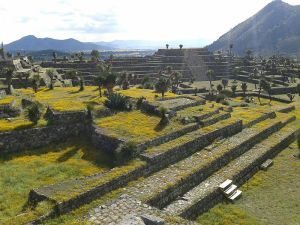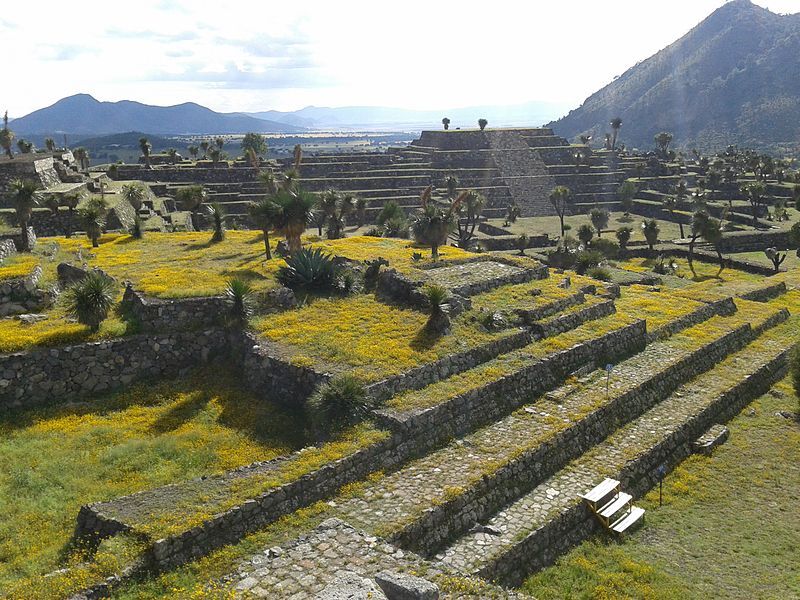
By comparing and analyzing paleoclimate and cultural data, researchers are suggesting that draught conditions may have had a major impact on the rise and fall of a pre-Columbian Mesoamerican city in central Mexico.
Known as Cantona, the city’s ancient remains lie east of Mexico City in the semiarid basin called the Cuenca Oriental. Occupied from 600 BCE to 1050 CE, it thrived as an important player in the obsidian trade, reaching a peak population of 90,000 inhabitants by about 700 CE. Between 900 and 1050 CE, however, the record shows a precipitous decline and then abandonment, correlated with the driest part of an arid interval between 500 and 1150 CE. But the researchers found that the history as revealed by the data is a bit more complicated than that.
Led by Tripti Bhattacharya of the University of California, Berkeley, and colleagues, the research team conducted geochemistry and oxygen isotope analysis of the sediments of Aljojuca lake, which is located near the remains of Cantona, and compared it with the archaeological record. What they found indicated a correlation between both periods of expansion and decline during dry intervals, not just wet-and-dry oscillations. More specifically, the researchers noted that the population expanded in its initial phase between 600 BCE and 50 CE during a wet period, but continued with a strong expansion between 50 and 600 CE, despite a gradual drying trend over this period. But more interesting still was their finding that “despite intensifying aridity between 500 CE and 1150 CE, population rose again in the period defined as Cantona III (600 – 900 CE), reaching an estimated peak of 90,000 at 700 CE.”* The researchers suggest a possible explanation for this might lie in theories proposed by archaeologists regarding migration of peoples from the north due to increasing aridity, among other factors. “This time period was likely one of turmoil elsewhere in highland Mexico,” they continue, “as a result of Teotihuacan’s earlier decline, the decline of Cholula between 650 CE and 850 CE, and eruptions of the volcano Popcatepetl. It is possible that this turmoil may have created a flux of migrants to other rising centers of regional power.”* The researchers noted that the great decline and final abandonment between 900 and 1050 CE was also marked by increased defensive construction works, coinciding with the most intense aridity in the record.
__________________________________________
 View of the remains of Cantona. AnheruAn, Wikimedia Commons
View of the remains of Cantona. AnheruAn, Wikimedia Commons
__________________________________________
 Platform mound construction at Cantona. Aleksms, Wikimedia Commons
Platform mound construction at Cantona. Aleksms, Wikimedia Commons
__________________________________________
The authors conclude that the study results may suggest a complex interplay between climate conditions and the political and societal conditions of Cantona and other city-states and settlements in Mesoamerica.
The detailed study* is published in the Proceedings of the National Academy of Sciences.
________________________________________________________
*Article #14-05653: “Cultural implications of late Holocene climate change in the Cuenca Oriental, Mexico,” by Tripti Bhattacharya et al.
________________________________________________________
Read about the most fascinating discoveries with a premium subscription to Popular Archaeology Magazine. Find out what Popular Archaeology Magazine is all about. AND MORE:
On the go? Get the smartphone version of Popular Archaeology as an app or as an ebook.
Just released!
The special new premium quality print edition of Popular Archaeology Magazine. A beautiful volume for the coffee table.
Travel and learn with Far Horizons.
____________________________________________
Popular Archaeology’s annual Discovery Edition eBook is a selection of the best stories published in Popular Archaeology Magazine in past issues, with an emphasis on some of the most significant, groundbreaking, or fascinating discoveries in the fields of archaeology and paleoanthropology and related fields. At least some of the articles have been updated or revised specifically for the Discovery edition. We can confidently say that there is no other single issue of an archaeology-related magazine, paper print or online, that contains as much major feature article content as this one. The latest issue, volume 2, has just been released. Go to the Discovery edition page for more information.








